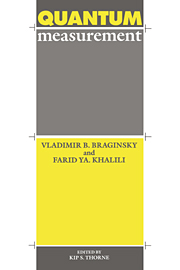Book contents
- Frontmatter
- Contents
- Dedication
- Editor's Foreword
- Notation
- Chapter I Historical introduction: photons and measurements using photons
- Chapter II The main principles of quantum mechanics
- Chapter III Indirect measurements
- Chapter IV Quantum nondemolition measurements
- Chapter V Linear measurements
- Chapter VI Continuous linear measurements
- Chapter VII Nonlinear systems for continuous measurements
- Chapter VIII Detection of classical forces
- Chapter IX Energetic quantum limitations
- Chapter X Devices for measuring small mechanical displacements
- Chapter XI Quantum nondemolition measurements of a resonator's energy
- Chapter XII Nonclassical states of electromagnetic waves as tools for quantum measurements
- Conclusion
- References
- Subject Index
Chapter VIII - Detection of classical forces
Published online by Cambridge University Press: 15 December 2009
- Frontmatter
- Contents
- Dedication
- Editor's Foreword
- Notation
- Chapter I Historical introduction: photons and measurements using photons
- Chapter II The main principles of quantum mechanics
- Chapter III Indirect measurements
- Chapter IV Quantum nondemolition measurements
- Chapter V Linear measurements
- Chapter VI Continuous linear measurements
- Chapter VII Nonlinear systems for continuous measurements
- Chapter VIII Detection of classical forces
- Chapter IX Energetic quantum limitations
- Chapter X Devices for measuring small mechanical displacements
- Chapter XI Quantum nondemolition measurements of a resonator's energy
- Chapter XII Nonclassical states of electromagnetic waves as tools for quantum measurements
- Conclusion
- References
- Subject Index
Summary
Aspects of quantum limits for the detection of a classical force
The development of the theory of QND measurements was triggered by the problem of detecting a small classical force that acts on a quantum probe―e.g. on a free mass or an oscillator, see the review article and the monograph. This problem arose most especially in gravitational-wave experiments. Astrophysical estimates indicate that the gravitational waves from cosmic sources should be so strong that they behave almost perfectly classically. During the measuring time the number of gravitons that pass within one wavelength of the measuring device is enormously larger than unity; and correspondingly, as would be the case if the waves were electromagnetic, quantum effects in the radiation are utterly negligible.
A central feature of gravitational waves is their extremely weak interaction with matter. Because of this weakness, the response of the measuring device's probe object to the waves is so small that it may be comparable to the object's quantum mechanical uncertainties. At the same time, the weakness of the interaction guarantees that there is almost no back action of the probe on the gravitational-wave field. As a result, the gravitational wave acts on the probe as through it were a precisely classical force (i.e. a force that is independent of the probe's quantum state).
- Type
- Chapter
- Information
- Quantum Measurement , pp. 105 - 124Publisher: Cambridge University PressPrint publication year: 1992



